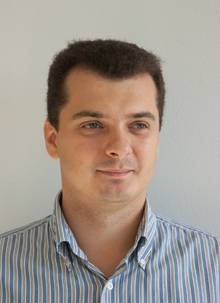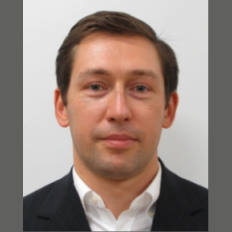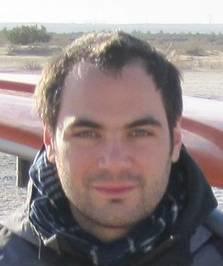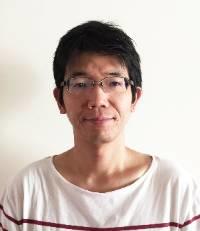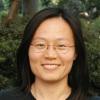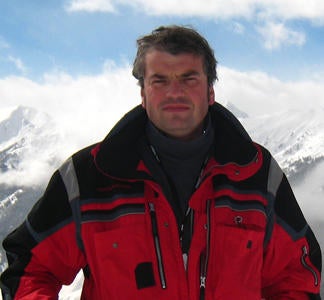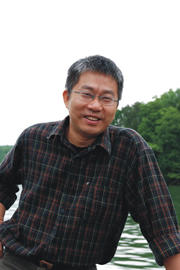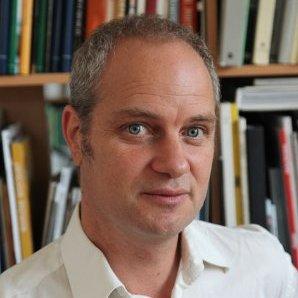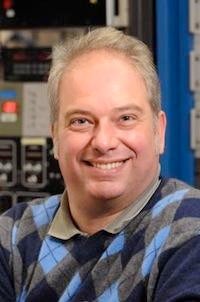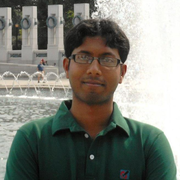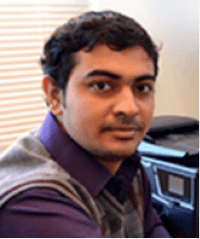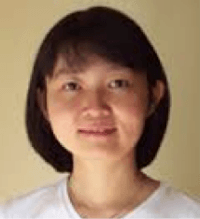EFRC Seminar Series
- February 21, 2020 MSE 117, UC Riverside
- Purely antiferromagnetic magneto-electric random access momery
- Dr. Denys Makarov
- Helmholtz-Zentrum Dresden-Rossendorf e. V. (HZDR)
Institute of Ion Beam Physics and Materials Research Bautzner Landstraße 400 01328 Dresden, Germany
Abstract: Magnetic random access memory schemes employing magnetoelectric coupling to write binary information promise outstanding energy efficiency. We propose and demonstrate a purely antiferromagnetic magnetoelectric random access memory (AF-MERAM) that offers a remarkable 50-fold reduction of the writing threshold compared with ferromagnet-based counterparts, is robust against magnetic disturbances and exhibits no ferromagnetic hysteresis losses. Using the magnetoelectric antiferromagnet Cr2O3, we demonstrate reliable isothermal switching via gate voltage pulses and all-electric readout at room temperature. As no ferromagnetic component is present in the system, the writing magnetic field does not need to be pulsed for readout, allowing permanent magnets to be used. Based on our prototypes, we construct a comprehensive model of the magnetoelectric selection mechanisms in thin films of magnetoelectric antiferromagnets, revealing misfit induced ferrimagnetism as an important factor. Beyond memory applications, the AF-MERAM concept introduces a general all-electric interface for antiferromagnets and should find wide applicability in antiferromagnetic spintronics.
- January 17, 2020 MSE 117, UC Riverside
- Magnetic bimerons as skyrmion analogues in in-plane magnets
- Dr. Oleg A. Tretiakov
- School of Physics, The University of New South Wales
-
Abstract: A magnetic bimeron is a pair of two merons and can be understood as the in-plane magnetized version of a skyrmion. Here we theoretically predict the existence of single magnetic bimerons as well as bimeron crystals, and compare the emergent electrodynamics of bimerons with their skyrmion analogues. We show that bimeron crystals can be stabilized in frustrated magnets and analyze what crystal structure can stabilize bimerons or bimeron crystals via the Dzyaloshinskii-Moriya interaction. We point out that bimeron crystals, in contrast to skyrmion crystals, allow for the detection of a pure topological Hall effect. By means of micromagnetic simulations, we show that bimerons can be used as bits of information in in-plane magnetized racetrack devices, where they allow for current-driven motion for torque orientations that leave skyrmions in out-of-plane magnets stationary.
- August 31, 2016 - UC Riverside
- Synchronization and coupled transport in networks of nonlinear oscillators
- Dr. Simone Borlenghi Garoia
- KTH (Royal Institute of Technology, Stockholm) and Uppsala University (Sweden)
Abstract: I will present an overview on recent research on the off-equilibrium discrete nonlinear Schrödinger equation. The latter is a general semi-classical model that describes networks of nonlinear oscillators, and has application in several branches of Physics, including Bose-Einstein condensates, spin systems, lasers, mechanical oscillators and photosynthetic reactions. When some oscillators of the network are coupled to stochastic bath at different temperatures, the system reaches non-equilibrium steady states where coupled currents (of energy and "particle") propagate. The essential condition for current propagation is the phase-synchronization of the oscillators, indicating a deep relation between irreversibility an phase-coherence. I will present several examples of realistic spin devices, where transport can be enhanced or suppressed by controlling the phase synchronization between the spin-oscillators, giving rises to interesting phenomena, such as thermal/spin rectification and a phenomenon similar to the Josephson effect of superconductivity
- August 24, 2016 - UC Riverside
- Anomalous Tunnel Hall Effect, Orbital Chirality, and Giant Universal Asymmetry
- Dr. Henri-Jean Drouhin
- Laboratoire des Solides Irradiés, Ecole Polytechnique
Abstract: Recently it was shown that the interplay of spin-orbit coupling (SOC) and exchange interactions at interfaces and tunnel junctions results in spectacular transmission asymmetries, giving rise to an anomalous tunnel Hall Effect (ATHE) for electrons and holes.(1,2) Similarly, striking tunneling phenomena have just been predicted arising in topological insulators.(3) While they all are related to the spin-orbit directional anisotropy, ATHE differs from the tunneling Hall effect,(4) spontaneous anomalous and spin Hall effects,(5) or spin-galvanic effect,(6) previously reported for electron transport by its giant forward asymmetry and chiral nature. A new class of tunneling phenomena can now be investigated and experimental work is under way. In this talk, I will discuss theoretical investigations and k. p calculations of exchange-split tunnel junctions based on III-V semiconductor compounds, involving SOC. A comparison will be made between simple quantum-mechanical calculations, transport perturbative techniques, and spin-orbit-assisted tunneling properties deduced from numerical calculations. It will be shown that, as far as SOC is included in the conduction band of exchange-split semiconductors, the electrons can be differently transmitted with respect to an axis orthogonal to both the axis normal to the interface and the magnetization direction. It is predicted that the transmission asymmetry for opposite incidence angles possibly reaches up to 100% at some points of the Brillouin zone, thus corresponding to a totally quenched transmission for given incidence angles. In the case of an exchange step, the universal character of the transmission asymmetry will be established. When valence bands are involved, it will be shown that the ATHE calculations rely on a subtle treatment of the spurious states and an insight into the topology of the complex band structure will be given. The present approach paves the way to a 30-band treatment enabling to address structures based on indirect-bandgap group-IV semiconductors. It will be highlighted how the transmission asymmetry is related to the difference of orbital chirality arising of the mixing of evanescent states with propagative states and to the related branching of the quantum states responsible for the tunneling current. In all cases, the asymmetry appears to be extremely robust.
Bio: Henri-Jean Drouhin graduated from the Ecole Polytechnique, France and obtained his PhD degree with habilitation (Doctorat d’Etat) from University Paris-Sud, Orsay (1984). He is presently researcher at Laboratoire des Solides Irradies (LSI, UMR 7642 CNRS &CEA/DSM/IRAMIS, Ecole Polytechnique, University Paris Saclay), where he is heading the “Physics and Chemistry of Nano-objects” group (PC-Nano). He is Associate Professor and Vice President of the Physics Department, as well as scientific advisor at the direction of academic affairs and research. He was the Dean of Studies at Ecole Polytechnique from 2000 to 2008 and Deputy Vice-President for Research from 2008 to 2014. He made leading contributions to semiconductor spin physics and to spintronics. He is the author of more than 80 scientific publications in first-rank peer-reviewed international journals. He gave about 28 invited talks and co-authored more than 20 contributed papers at international conferences. He wrote several book chapters, and contributed to a textbook devoted to semiconductor physics. He was an Editor of the European Journal of Applied Physics (EPJAP) from 2003 to 2015. He is a member of the American Physical Society and he was elected Fellow of the SPIE in 2007. He was decorated Chevalier Legion of Honor (French Pres., 2002) and Officer of the National Order of Merit (French Pres., 2009).
- March 11, 2016 - UC Riverside
- Magnetostatic spin wave analog of integer quantum Hall states
- Professor Ryuichi Shindou
- International Center for Quantum Materials, School of Physics Peking University
Abstract: Topological phases have been explored in various fields in condensed matter physics such as semiconductor physics, correlated electron systems, liquid helium-3, cold-atomic systems, and photonics. This leads to the recent foundation of emerging materials such as topological insulators, topological superfluids and topological photonic crystals. In this talk, I will review our theory proposal of magnetostatic spin-wave analog of integer quantum Hall states, which support a unidirectional spin-wave propagation along the boundary of systems. Magnetostatic spin wave is a collective magnetic excitation in solid, whose wavelength is much longer than short-range exchange interaction length. Spin wave in such long-wave length regime (typically micrometer scale) is usually driven by magnetic dipole-dipole interaction instead of short-range quantum-mechanical exchange interaction. As is clear from the form of the Maxwell equation, the dipolar interaction also has a role of locking the relative rotational angle between spin and coordinate vector, i.e. spin-orbit locking. I will first introduce the topological Chern integer in the context of the Landau-Lifshitz equation, and argue how the non-zero topological integer guarantees the existence of chiral spin-wave modes in general. I will then argue that, due to the spin-orbit locking nature of the dipolar interaction, two-dimensional ferromagnetic thin films with a periodic structuring can host magnetostatic volume-mode bands with non-zero Chern integers and chiral magnetostatic edge modes which realize unidirectional spin transport. The existence of such edge mode is justified by straightforward diagonalization of a linearized Landau-Lifshitz equation and also micromagnetic simulations. I will also argue our recent theory study of quantum Hall "plateau-to-plateau" transition probed by the magnon quantum Hall insulator with randomness/disorders.
- February 19, 2016 - UC Riverside
- 2D materials for spintronics - Topological Insulators and Graphene
- Dr. Ching-Tzu Chen
- IBM Thomas J. Watson Research Center
Abstract: Novel two-dimensional electronic systems present unique opportunities for spintronic applications. In this seminar I will discuss two specific examples. First, we explore the potential of interfacial exchange interaction in 2D materials for spin control. Using graphene as a prototype, we demonstrate that its coupling to a model magnetic insulator (EuS) produces a substantial magnetic exchange field (> 14 T), which yields orders-of-magnitude enhancement in the spin signal originated from the Zeeman spin-Hall effect. Furthermore, the strong exchange field lifts the spin degeneracy of graphene in the quantum Hall regime, which may lead to interesting spin-polarized edge transport and thus open up new application space for classical and quantum information processing. Next we examine the potential of topological insulators as spin-source materials. Using a new spin-polarized tunneling method, giant charge-spin conversion efficiency in topological insulators is revealed, well exceeding that in conventional magnetic tunnel junctions. Through a comparative study between Bi2Se3 and (Bi,Sb)2Te3, we verify the topological-surface-state origin of the observed giant spin signals and further extract the energy dependence of the effective spin polarization in Bi2Se3.
Bio: Ching-Tzu Chen is a Research Staff Member at the IBM Thomas J Watson Research Center. She graduated with a BS degree from National Taiwan University and received her PhD in physics from the California Institute of Technology. Her doctoral research focuses on the studies of scanning tunneling spectroscopy in high-temperature cuprate superconductors, for which she was awarded the Schlumberger fellowship and Los Alamos National Laboratory Director Fellowship. In July 2007, she joined the IBM Watson Physical Sciences Department and has since participated in various projects related to iron-pnictide superconductivity, graphene nanostructures and spintronics, and spin-orbit physics. Her work on iron-pnictide superconductivity and graphene has been awarded the IBM Outstanding Achievement Award and Invention Achievement Award. Her most recent research focuses on topological insulators, spin Hall metals, magnetic thin films and quasi-2D systems for spintronics applications.
- February 12, 2016 - UC Riverside
- Nano-photonic phenomena in van der Waals heterostructures
- Professor Dimitri N. Basov
- Department of Physics, UCSD
Abstract: Layered van der Waals (vdW) crystals consist of individual atomic planes weakly coupled by vdW interaction, similar to graphene monolayers in bulk graphite. These materials can harbor superconductivity and ferromagnetism with high transition temperatures, emit light and exhibit topologically protected surface states. An ambitious practical goal is to exploit atomic planes of vdW crystals as building blocks of more complex artificially stacked heterostructures where each such block will deliver layer-specific attributes for the purpose of their combined functionality. We investigated van der Waals heterostructures assembled from atomically thin layers of graphene and hexagonal boron nitride (hBN). We observed a rich variety of optical effects due to surface plasmons in graphene [Reviews of Modern Physics 86, 959 (2014)] and hyperbolic phonon polaritons in hBN [Science 343, 1125 (2014)]. We launched, detected and imaged plasmonic, phonon polaritonic and hybrid plasmon-phonon polariton waves in a setting of an antenna based nano-infrared apparatus [Nature Materials 14, 1217 (2015)]. Peculiar properties of hyperbolic phonon polaritons in hBN enabled sub-diffractional focusing in infrared frequencies [Nature Comm. 6, 6963 (2015)]. Because electronic, plasmonic and phonon polaritonic properties in van der Waals heterstructures are intertwined, gate voltage and/or details of layer assembly enable efficient control of nano-photonic effects [Nature Nano 10, 682 (2015)]. I will also discuss an ability to manipulate plasmonic response of in these structures at femto second time scales that we have demonstrated using a novel technique of pump-probe nano-infrared spectroscopy [Nature Photonics (2016)].
Bio: Dmitri N. Basov (PhD 1991, Russian Academy of Sciences) is a professor (since 1997) and Chair (2010-15) of Physics, University of California San Diego. Research interests include: physics of correlated electron systems, superconductivity, two-dimensional materials, infrared nano-optics. Prizes and awards: Sloan Fellowship (1999), Genzel Prize (2014), Humboldt research award (2009), Frank Isakson Prize, American Physical Society (2012), Moore Investigator (2014).
- January 8, 2016 - UC Riverside
- Scanning Tunneling Microscopy Study on Emergent Materials
- Professor Minn-Tsong Lin
- National Taiwan University
Abstract: We present here the study of scanning tunneling microscopy (STM) on emergent materials. It often requests information not only on morphology, but also the local electronic structure. Scanning tunneling spectroscopy (STS) is almost the only approach to monitor the local electronic structure in nanometer scale for material surface, and further with help of a magnetic tip, can be spin-sensitive, becoming spin-polarized STM. Several examples will be given in this talk. The first one is the 2-D network of Fe-PTCDA (perylene-3,4,9,10-tetracarboxylic-3,4,9,10-dianhydride) grown on Au(111) [1]. In this case, the STS study indicates that the frontier orbital shifts of the PTCDA molecules are correlated with the metal-organic coordination number, which affects the magnitude of charge transfer onto each PTCDA in the Fe-PTCDA hybridization system. SP-STM also provides the spin-response of the organic molecules when they are deposited on magnetic Co islands. [1,2] Another system is the surface of semiconductor BiTeI [3] with strong spin-orbit coupling, which is of great interest for use in spintronic devices exploiting the Rashba effect. Using spatially resolved tunneling spectroscopy across the lateral boundary between the two terminations, a previously speculated on p-n junction-like discontinuity in electronic structure at the lateral boundary is confirmed experimentally. These findings realize an important step towards the exploitation of the unique behavior of the Rashba semiconductor BiTeI for new device concepts in spintronics. Moreover, in the system of topological insulator (TI) Bi2Se3, we demonstrate that formation of Fe-PTCDA hybrids can remove interactions between the Fe dopant and the Bi2Se3 surface, revealing the functionality of PTCDA to prevent dopant disturbances in the topological surface state and providing an effective alternative for interface designs of realistic TI devices. [4]
Bio: Prof. Minn-Tsong Lin is Distinguished Professor at Department of Physics, National Taiwan University. He obtained his bachelor’s degree from National Taiwan University, Diplom-Phyisker (master degree) from University of Heidelberg, Germany, and his Ph.D. from Department of Physics, University of Halle, with the thesis supervised at Max-Planck-Institute of Microstructure Physics, Germany. He is also serving now as Associate Editor of Applied Physics Letters. Prof. Lin was studying the complex interplay among the electronic and structural factors governing the nanomagnetism and spin-dependent transport in ultrathin magnetic films and (organic) spintronic and nanomagnetic systems. Recently, he focuses his research work on spintronics with emergent materials, such as topological insulator and Rashba-semiconductor.
- August 17, 2015 - UC Riverside
- Inertial regime of the magnetization: The reminiscence of the fast degrees of freedom expressed on the Geometrical phase
- Professor Professor Jean-Eric Wegrowe
- École Polytechnique Université Paris-Saclay
Abstract: It is well known that the Landau-Lifshitz-Gilbert (LLG) equation for a macroscopic magnetic moment find its theoretical limit at very short time scales or equivalently at very high frequencies. The reason for this limit of validity is well understood in terms of separation of the characteristic times between slow (the magnetization) and fast (the environment) degrees of freedom, as pointed-out in the stochastic derivation of the LLG equation first proposed by W. F. Brown in 1963 [1]. Indeed, the ferromagnetic moment is a slow collective variable, but fast degrees of freedom are also playing a role in the dynamics, and especially the angular momentum responsible for inertia. In the last couple of years, the generalization of the LLG equation with inertia (ILLG) has been derived by different means [2,3,4]. The signature of the inertial regime of the magnetization is the nutation oscillation - added to the usual precession - that can be measured by resonance experiments (unfortunately not investigated up to know). However, we can show that even for the pure precession movement, the fast degrees of freedom can also play an important role. We developed an approach in terms of geometrical phase (defining the corresponding Hannay angle [5], which is the classical analog to the quantum Berry phase), that has recently been used with success to analogous problems [6]. We calculated the Hannay angle for the precession of the magnetization in the case of the inertial effect. This analysis allows the slow vs. fast variable expansion to be calculated in the specific case of pure precession. The result is interpreted in terms of classical magnetic monopole.
Bio: Since 2002, Jean-Eric Wegrowe is associate professor at the Physics Department of Ecole Polytechnique (Palaiseau, south Paris). He is in charge of regular courses in quantum mechanics, statistical physics, and solid state physics. In 1996 he defended his PhD about the dynamics of the magnetization in magnetic nanostructures (at Louis Néel Laboratory, Grenoble, France). From 1996 to 2002 he got a post-doctoral position and subsequently he became first assistant at the EPFL in Lausanne, Switzerland. The research activities of Jean-Eric Wegrowe focus on the study of transport properties of nanostructures, using diverse experimental and theoretical techniques. His research interests include new fabrication methods of nano-objects [1], the study of electric and thermal transport properties (especially in metals, carbon nanotubes and semiconductor nanowires) [2] and the study of spin-dependent transport with the first measurements of spin-transfer effect [3,4]. He is also developing measurements about spin-dependent thermoelectric effects [5] and entropy generated by spin transfer [6]. In parallel, he developed various theoretical approaches in order to understand the physical properties of spin-currents [7, 8] (pointing-out the dichotomy between dissipative [7] and non-dissipative [8] approaches). He is also studying dynamical properties of the magnetization, with the prediction of inertial effects for uniform magnetization [9, 10]. He has a hundred publications (h index 21) and 4 patents [11].
- June 5, 2015 - UC Riverside
- Magnetism at the Mesoscale: Harnessing Competing Interactions
- Dr. Axel Hoffman
- Argonne National Laboratory
Abstract: Magnetic interactions give rise to a surprising amount of complexity due to the fact that both static and dynamic magnetic properties are governed by competing short-range exchange interactions and long-range dipolar coupling. Even though the underlying dynamical equations are well established, the connection of magnetization dynamics to other degrees of freedom, such as charge and heat flow, make magnetism a mesoscale research problem that is still wide open for exploration. Synthesizing magnetic materials and heterostructures with tailored properties allows to take advantage of magnetic interactions spanning many-length scales, which can be probed with advanced spectroscopy and microscopy and modeled with micromagnetic simulations. In this talk, I will discuss two examples highlighting current opportunities in mesoscale magnetism. First, I will show how local Oersted magnetic fields from charge currents can manipulate the propagation of spin waves, enabling the guidance of spin-waves through curved waveguides and the switching of spin waves between multiple waveguides. Second, I will show how spin Hall effects can be used to electrically manipulate magnetostatically stabilized magnetic skyrmion structures. Using inhomogenous electric charge currents even allows the generation of skyrmions in a process that is remarkably similar to the droplet formation in surface-tension driven fluid flows. This work was supported by the U.S. Department of Energy, Office of Science, Materials Sciences and Engineering Division.
Bio: Dr. Axel Hoffmann is currently the Group Leader of the Magnetic Films Group within the Materials Science Division of the Argonne National Laboratory, which he joined in 2001 as a staff member. His research interests encompass a variety of magnetism related subjects, including basic properties of magnetic heterostructures, spin-transport and magnetization dynamics in novel geometries, and biomedical applications of magnetism. He has more than 100 publications with combined more than 3000 citations (h-index: 33). In addition he published four book chapters, one book, and three magnetism related U.S. patents. He has presented more than 200 invited talks at conferences and research institutions. Currently he is an associate editor for the Journal of Applied Physics. He is a fellow of the American Physical Society and IEEE. Furthermore, in 2011 the IEEE Magnetics Society selected him as a Distinguished Lecturer and in 2015 he was awarded as “Outstanding Researcher” by the Prairie Section of the American Vacuum Society.
- May 22, 2015 - UC Riverside
- Hybrid Spintronics and Straintronics: An ultra-energy-efficient approach for nanomagnetic logic and memory
- Ayan Kumar Biswas
- Virginia Commonwealth University
Abstract: A major research theme in electronics is to reduce the amount of energy dissipated in a binary operation since that will allow continued downscaling of electronic devices in accordance with Moore’s law. Unlike charge-based CMOS technology, spin-based nanomagnetic technology, that envisages switching the bistable magnetization of a shape anisotropic nanomagnet for a binary operation, has the potential to achieve ultralow energy dissipation because switching does not involve moving electrical charge. However, this potential has never been realized because most magnet switching schemes involve generating a current to produce either a magnetic field, or spin transfer torque, or domain wall motion. Current-induced switching invariably dissipates an exorbitant amount of energy in the switching circuit that nullifies any energy advantage that a magnet may have over a transistor. Magneto-elastic switching (switching the magnetization of a magnetostrictive magnet with voltage generated stress) is an unusual switching paradigm where the total dissipation turns out to be merely few hundred kT in a particular switching event – several orders of magnitude less than that encountered in current-based switching. A fundamental obstacle, though, is to deterministically switch the magnetization of a nanomagnet between two stable states that are mutually anti-parallel with stress alone. In this work, I have investigated several ways to mitigate this problem. This can result in a new genre of extremely energy-efficient non-volatile memory technology where bits are written into cells with voltage generated stress. We have also proposed a universal NAND logic device that satisfies all the essential characteristics of a Boolean logic gate. A bit comparator is proposed as well, which happens to be all straintronic, yet reconfigurable. Furthermore, a straintonic spin neuron is proposed for neural computing architectures and it dissipates orders of magnitude less energy than its CMOS based counterparts. In future, we expect to experimentally demonstrate 180o switching with strain in a Co nanomagnet.
Bio: Ayan Kumar Biswas is a third year graduate student of Electrical and Computer Engineering at Virginia Commonwealth University. He received a B. Sc degree in Electrical and Electronic Engineering from the Bangladesh University of Engineering and Technology (BUET), Dhaka, Bangladesh. In the Fall of 2012, he moved to Richmond, Virginia, USA as a graduate student of Electrical and Computer Engineering at Virginia Commonwealth University and in the Spring of 2013, he joined in Quantum Device Laboratory as a research assistant under the supervision of Prof. Supriyo Bandyopadhyay. Since then, he has been working on modeling and simulation of ultralow energy hybrid straintronic-spintronic devices. He has authored and co-authored 8 journal papers (including published and under-review), one book chapter (in press) and one US-patent (pending). Ayan is a recipient of the School of Engineering Phi Kappa Phi scholarship and Outstanding Graduate Research Award at Virginia Commonwealth University. He also received a GMAG student travel award during the 2015 APS March meeting.
- April 10, 2015 - UC Riverside
- Thermal transport in isotope substituted nanomaterials: From fundamentals to design
- Professor Ganesh Balasubramanian
- Iowa State University
Abstract: Thermal conductivity in nanomaterials such as carbon nanotubes (CNT) and graphene nanoribbons (GNR) is governed by lattice vibrations (also called phonons) and the various energy scattering phenomena associated with them. Impurities such as atomic vacancies, dopants and isotopes enhance the scattering effects, further reducing the energy transfer ability of these materials. We present results from quantum mechanical and classical molecular simulations on the effects of isotopes on the thermal conductivity of CNTs and GNRs. Strong shifts in the characteristic vibrational frequencies of the phonon modes are observed in the mass disordered structures that decrease the energy carrying capacity of the nanomaterials. Our investigations reveal that contrary to intuitive understanding the out of plane modes in a graphene sheet contribute significantly to thermal transport through them. An ordered arrangement of these isotope impurities can facilitate engineering of material systems for targeted thermal transport behavior. Results from our recent efforts at employing informatics and optimization tools show the importance of high frequency modes in the vibrational spectra towards designing mass disordered structures for desired thermal conductivities.
Bio: Ganesh Balasubramanian has been an Assistant Professor of Mechanical Engineering at Iowa State University since 2012. He received his BS degree in Mechanical Engineering from Jadavpur University, India in 2007, his PhD in Engineering Mechanics from Virginia Tech in 2011, and was a postdoctoral research associate in the Theoretical Physical Chemistry unit at Technische Universität Darmstadt in Germany. Some of his recognitions include the 2015 ASEE/AFOSR Summer Faculty Fellowship, Miller Faculty Fellowship at Iowa State, and the Graduate Man of the Year and Liviu Librescu Scholarship at Virginia Tech.
- November 14, 2014 - UC Riverside
- Probing Magnons and Phonons using Brillouin Light Scattering
- Professor Xiaoqin Li
- University of Texas-Austin
Abstract: When light interacts with quasiparticles in solids such as phonons (coordinated lattice vibrations) and magnons (coordinated spin rotations), annihilation or creation of a quasiparticle leads to inelastically scattered light at higher or lower frequency known as the Anti-Stokes and Stokes peaks in the familiar Raman scattering. The principle of Brillouin light scattering is identical to Raman scattering, except that the experimental technique is modified to monitor low frequency quasiparticles (1 GHz-150 GHz) such as magnons and acoustic phonons. I will present two examples in this talk. In the first example, we study the how spin waves (or magnon) can be amplified or attenuated by a direct current passing through a heavy metal/ferromagnetic bilayer via the spin Hall effect. In the second example, we discuss how Brillouin light scattering can be used as a temperature sensor for acoustic phonons in silicon.
Bio: Dr. Xiaoqin (Elaine) LI obtained her Master degree in Electrical Engineering in 2002 and her PhD in physics in 2003 from the University of Michigan. After a postdoctoral fellowship at JILA, Colorado, She joined the physics department at University of Texas-Austin in 2007. Her group is currently exploring unique properties of metallic and hybrid nanostructures, spin waves in micromagnetic devices, and atomically thin semiconductors. In recent years, Dr. Li has received a number of awards which include the Sloan fellowship, the NSF CAREER award, and the Presdential Early Career Award for Scientists and Engineers (PECASE).

